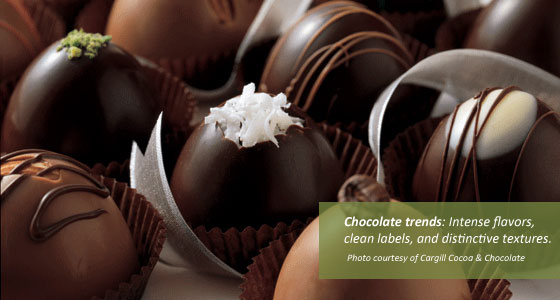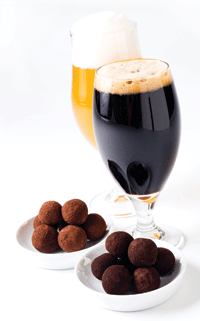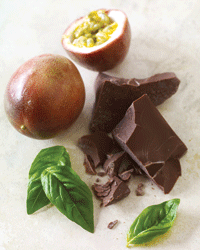Chocolate Everything
INGREDIENTS

Chocolate. It’s one of the most powerful words in the food lexicon, bringing to mind images of comfort, indulgence, and taste. More recently, chocolate also has potential implications for health, either by itself or in its pairings with better-for-you ingredients ranging from nuts to green tea to exotic fruits.
Chocolate continues to be found in traditional applications such as bakery products, confections, and ice cream. However, even some of these traditional applications aren’t exactly what we have typically imagined. Take, for example, a new line of chocolates from Marich Confectionery, Hollister, Calif., a manufacturer of a wide variety of chocolate-covered confections. New creations launched from this company included Milk Chocolate Bacon Toffees and Dark Chocolate Sea Salt Caramels.
But the use of chocolate isn’t stopping there, as it finds opportunities in a wider range of nontraditional products. In fact, these days there seem to be no limits as formulators use chocolate in just about everything. Recently, General Mills launched its Chocolate Cheerios. Nutella, a chocolate almond paste long popular in Europe, has been increasingly gaining use in the United States. And even Cool Whip has caught the chocolate mania as it is introducing a new line of whipped and easy-to-spread frosting available in a chocolate version.
While combining chocolate with peanut butter was a brilliant idea at the time—and in my opinion still remains a brilliant concept—chocolate as of late has certainly made many other ingredient mergers to create new launches ranging from waffles to yogurts to beverages. And chocolate is finding use in savory applications as well. Imagine biscuits and chocolate gravy. Or a mole sauce over slowcooked pork.
This article will look at some of the growing trends related to chocolate, ingredient innovations that are making possible the expanding use of chocolate, and some of the potential applications that employ chocolate.
Top Food Trends for Chocolate
The top 10 trends in foods for 2013, based on research conducted by Innova Market Insights, and how they relate to cocoa and chocolate applications, have been revealed in a recent webinar. The webinar, “Inspiring 2013 Food Trends for Your Cocoa and Chocolate Applications,” was presented by Lu Ann Williams of Innova Market Insights and Rens de Haan, Marketing & Communications Director of Cargill Cocoa & Chocolate. The following are the top 10 trends discussed.
1. The Aware Shopper. Today’s consumer, who is more informed and knowledgeable about value and health, is increasingly influencing the market. While they care about the environment and ethically produced goods, they still demand convenience. Chocolate products that reflect an ethical positioning (sustainability, environment friendly, fair trade) allow consumers to “do good” with their purchase. Portions of the product’s proceeds frequently go back to charities or the addressing of certain causes. Also reflected in this trend are simple, clear, and transparent labels on chocolate products, which appeal to consumers because they know exactly what they’re purchasing.
2. Healthy Traffic Jams. Although there have been crackdowns on health claims, there are still opportunities for brands that communicate “healthy indulgence.” These products are being promoted for their inherent naturalness or nutritional value. Some examples might include chocolate that is a source of vitamins D & E; organic raw chocolate infused with cranberry and mandarin; sugar-free chocolate-covered wolfberries; antioxidant-enriched chocolate products; and dark chocolate products, which studies have shown can be good for the heart or blood circulation.
3. Gray but Healthy. This trend focuses on healthy aging and how aging consumers are selecting products that can help them age more healthfully. Discussed were collagen-containing chocolate, chocolate that delivers on protein, chocolate-covered caramel “calcium bites,” and chocolate for gut health.
4. Just Say No. Free-from claims are becoming increasingly prevalent. Gluten-free is now relatively mainstream, with lactose-free set to follow suit as awareness of problems associated with nutrient intolerance rises and technological advances improve the quality and availability of the product. Chocolate products were described that target those consumers with allergies or intolerances to gluten, soy, dairy, certain preservatives, and others. Global launch numbers for lactose-free chocolate products more than tripled over the past five years.
5. Natural Cracks Emerge. Lawsuits and regulatory pressure are rising over concerns about the definition of “natural” and whether highly processed foods should be using that description. As a result, some chocolate companies are switching to “additive/preservative-free” positionings, while the use of GM-free claims is also growing in popularity. Interestingly, some companies are using claims such as “contains naturally occurring sugars,” which is much more specific (while still taking advantage of the word natural) instead of the more encompassing claim of “all natural.” Organic chocolate and its appeal to consumers was also covered under this trend.
6. Protein Overdrive. Protein is a hot topic today, helping to build muscle mass and providing a sense of satiety or fullness. There are many different opportunities for chocolate to deliver protein, especially from plant-based sources. Peas, nuts, and seeds are being used as inclusions to provide protein in chocolate.
--- PAGE BREAK ---
7. Beating the Sugar Demon. With diabetes on the rise, consumers are well aware of the health risks of eating too much sugar. In response, formulators are developing chocolate with sugar alternatives that still maintain the indulgence of chocolate. The number of chocolate products tracked with a “no added sugar” claim increased by 130% from the first half of 2011 to the first half of 2012. Stevia accounts for 68% of the chocolate products tracked with a “no sugar added” claim in 2012. Polyols have also played a significant role in chocolate.
8. Sensory Experience. Health plays an important part in formulating, but let’s not forget indulgence and the sensory experience. There is an increase in product launches tracked with new texture types, either as a result of novel applications or a combination of existing ones. One example is caramelized and lightly salted popcorn covered in milk chocolate, which delivers a novel texture while providing a combination of sweet and salty flavors. There are a variety of new ways to add appeal to chocolate through unusual mixes of textures and flavors. Through co-branding efforts, milk chocolate can be filled with Oreo cookie pieces or Oreo biscuit pieces. For kids especially, there are opportunities such as a milk chocolate bar with crispy multicolored dragee pieces or chocolate in fun shapes such as penguins.
9. More With Less. This trend discusses the balancing of environmentally friendly packaging with the creating of indulgent chocolate products.
10. Interest at the Extremes. More chocolate products are now positioned around the creation of intense flavors. This trend is partly stimulated by the elderly who need more flavor because they have less receptive palates. Some examples might be Intense Dark Chocolate M&Ms, dark chocolate products with wasabi flavor, savory crackers in chocolate, and a warm fruit dessert made with white chocolate.
Inspiring Innovation
In the webinar, Cargill shares expertise with customers to provide inspiration for their product innovation and to help them exceed consumer expectations. “Sustainability, reflected in the ‘Aware Shopper’; organic, within the ‘Natural Cracks Emerge’ trend; and new taste and texture combinations, as exhibited in the ‘Sensory Experience’ trend, are emerging as some of the most relevant relating to cocoa and chocolate in 2013,” noted Rens.
“However, as important as it is to be aware of these trends, it is how manufacturers respond to them and anticipate their consumers’ demands that is vital,” Rens added. “Partnership is a valuable strategy to achieve this, and Cargill is the ideal innovation partner through its ‘T-model’ approach.”
This approach combines broad food knowledge with deep cocoa and chocolate expertise, providing manufacturers with the support they need to create innovative solutions, explained Rens. “Whether working in confectionery, bakery or biscuits, cereals, dairy, or ice cream, the T-model enables manufacturers to get a head start in cocoa and chocolate developments in 2013, keeping one step ahead of the competition.”
Rens concluded, “With our many years of experience in cocoa, chocolate, and broad food applications, plus the expertise of our people, Cargill is one of the few companies that can support customers in their product development so they can meet and exceed the demands of consumers.”
 Cargill Cocoa & Chocolate offers the food industry a wide range of both standard and customized cocoa and chocolate ingredients to be used in bakery, confectionery, and dairy applications all over the world. Its product range includes Gerkens ® cocoa powders; and chocolate under Wilbur ®, Peter’s ®, and Veliche ® brands; and a variety of coatings, fillings, cocoa liquors, and cocoa butters. The company also supports its customers in new recipes and product development.
Cargill Cocoa & Chocolate offers the food industry a wide range of both standard and customized cocoa and chocolate ingredients to be used in bakery, confectionery, and dairy applications all over the world. Its product range includes Gerkens ® cocoa powders; and chocolate under Wilbur ®, Peter’s ®, and Veliche ® brands; and a variety of coatings, fillings, cocoa liquors, and cocoa butters. The company also supports its customers in new recipes and product development.
Over the past two years, Cargill has developed several ingredient innovations. For example, a new Dutch Dark range of powders combines an intense dark color with a smooth chocolaty taste, and is available in a variety of high- and low-fat versions. The range provides an opportunity to innovate and develop new recipes in different applications, claims the company. One product in the range is high-fat Gerkens ® Holland DS150, which has a premium dark color and is particularly suited for use in desserts and ice cream. The smooth taste of Dutch Dark powders also means that there is no need to use sugar to mask the bitterness that can be associated with dark powders. This is a potential benefit for those customers wishing to develop recipes with less sugar.
Cargill’s cocoa and chocolate business has also developed a new product innovation in cocoa powder that is said to greatly improve wettability and dispersability in cold drink mixes. This development means that the company’s cocoa powder disappears twice as quickly below the surface of the cold liquid (wettability) and will disperse evenly through the liquid (dispersability). As a result, drink mixes using the new cocoa powders are truly putting the “instant” into instant cocoa drinks. Furthermore, this performance will be maintained throughout the product’s shelf life—something that the company claims doesn’t hold true for existing products, which suffer from decreasing wettability as they near the end of their shelf life. In addition, this development also opens up the possibility of varying the balance of sugar and cocoa in recipes as it allows for lower amounts of sugar to be used. This will enable producers to offer a broader variety of options, such as a lower-calorie drink, or one with a stronger chocolate taste, depending on preference. The first Gerkens cocoa powder featuring this new technology was launched in 2012.
A prototype application, a chocolate pretzel made with sweet dough extruded into a pretzel shape, demonstrated the benefits of adding Oliggo-Fiber ® inulin, an invisible fiber derived from chicory root. Inulin can be easily added to the pretzel prototype with very little impact on a product’s taste, functionality, or appearance. Inulin also offers benefits beyond those traditionally associated with fiber. Reseach shows it can help enhance calcium absorption among pre-teens and post-menopausal women. As a prebiotic, it also helps to maintain digestive balance.
Cargill Cocoa & Chocolate has facilities in Belgium, Brazil, Canada, Cote d’Ivoire, France, Germany, Ghana, the Netherlands, the United Kingdom, and the United States. To secure a good quality and sustainable supply of cocoa beans, the company has its own cocoa bean sourcing operations for buying, handling, or exporting of cocoa beans in Brazil, Cameroon, Cote d’Ivoire, Indonesia, and Vietnam. A presence in all of the leading producing countries allows Cargill to oversee the supply chain from beans at origin to finished cocoa and chocolate products. In addition, extensive market research and analysis proves to be a source of valuable information for customers.
More information can be provided by Cargill Cocoa & Chocolate, Lititz, Pa. (www.cargillcocoachocolate.com).
--- PAGE BREAK ---
Creating Alternatives to Traditional Milk Chocolate
A number of new ingredient innovations for use in chocolate have been recently launched by Barry Callebaut, a leading manufacturer of chocolate and cocoa products. These developments reflect the importance of developing healthy yet delicious chocolate products while responding to evolving modern-day consumer needs.
Several of these were highlighted at the Health Ingredients Exhibition in Frankfurt, Germany, which took place November 13–15, 2012.
Meeting the demands for alternative sweetening solutions in chocolate, Barry Callebaut developed Sweet by Fruits ™, reportedly the first chocolate on the market that is sweetened by all-natural sugars derived entirely from fruits. Fruits by nature contain different sugars such as glucose, fructose, sucrose, polyols, and complex sugars. This chocolate product uses the entire sugar profile of the selected fruits, noted Hans Vriens, the company’s Chief Innovation Officer.
“This chocolate does not contain any added refined sugar and no added artificial sweeteners,” emphasized Vriens. It is made from selected cocoa and sweetened by sugars from fruits such as apples and grapes without compromising the taste of the chocolate.
In addition to this product, Barry Callebaut presented other sweetener solutions including dark chocolate sweetened with stevia extract. On November 12, 2011, the European Union approved stevia extract as an additive for use in foods and beverages. With this approval, Barry Callebaut can offer the sweetness extracted from stevia leaves for use in chocolate with no added sugars. The new chocolate can be used in a variety of applications, including molding, enrobing, and inclusions, or customized for a specific application to provide food manufacturers a one-of-a-kind chocolate solution.
In developing the new chocolate, the company replaced sugar with an all-natural sweetener solution that consisted of dietary fibers, the natural sugar erythritol, and stevia extract. The sweetener solution offers zero calories per serving. The new product is said to maintain the same taste, texture, and aroma as traditional chocolate.
The increased awareness of allergies and food intolerances has boosted the popularity of the “free-from” food category. People with food intolerances are constantly looking for healthy ingredients and desirable taste. Dietary restrictions are no longer an obstacle to enjoy the rich flavors of chocolate. As part of its wide “free-from” range, Barry Callebaut offers lactose-free milk chocolate with a milky taste similar to regular milk chocolate but without lactose. The new chocolate differs from existing offerings by using a special skimmed milk powder with the lowest lactose content available on the market. With this particular powder, the company can allow higher amounts of milk powder in its recipe, which allows the chocolate to have a taste similar to that of regular milk chocolate. For the production of this lactose-free chocolate, special measures were taken, including additional and specific cleaning of the production lines to eliminate the risk of any lactose contamination during the manufacturing process.
Barry Callebaut also developed a cocoa-based confectionery product that offers the same color and smooth texture of milk chocolate without the use of any milk ingredients, such as milk powder, milk proteins, butter oil, or any other milk derivatives. To create the 100% dairy-free alternative to milk chocolate, the company found a way to introduce a special blend of rice powder, inulin, and special natural flavorings to cocoa liquor and sugar. Neutral in taste compared to other dairy substitutes, rice powder is said to be an ideal substitute to milk powder, giving the end product a light, creamy, milk chocolate-like flavor. In addition, its fine particle size creates a texture and flavor experience similar to traditional milk chocolate.
Through these new developments Barry Callebaut works on making chocolate accessible to everyone, including individuals with special needs such as those that require gluten-free, dairy-free, lactose- free, and sugar-free ingredients. Products made with these special innovations were highlighted at the HIE show.
New Cocoa Powder Provides Intense Flavor
A new intense cocoa powder, deZaanTM D11SQ, has been launched by ADM Cocoa, Decatur, Ill. (phone 800-637-5843, www.adm.com). The dark red-brown powder confers intense flavor and rich color to a broad range of products, including bakery products, cereals, confections, and ice cream.
Ideal for products requiring intense flavor and visual appeal, the powder is said to provide a strong, clean cocoa taste and bridges the gap between popular brown and red powders. ADM Cocoa introduced the product to meet increasing consumer demand. The use of intense flavored cocoa powders has steadily risen over the past five years in a number of applications including baked goods, beverages, desserts, and ice cream. The powder can help manufacturers lower costs without affecting quality by allowing them to use smaller quantities to achieve the same or better results than conventional products. The new powder provides the same full body flavor and impact level but at a lower dose rate than standard powders.
At the 2012 IFT Food Expo®, ADM also highlighted prototype applications made with some of its other cocoa powders. For example, a chocolaty peanut spread consisted of cocoa, crystalline fructose, interesterified oleic soybean oil, high-oleic soybean oil blend, and lecithin. The sweet spread topped whole-wheat graham crackers. Also highlighted was a chocolate ice cream bar made with deZaan cocoa powders and then covered in a chocolate coating that featured ADM cocoa liquor and cocoa butter, making this dessert a sweet ending to any meal.
 Brewing Chocolate and Beer in Truffles
Brewing Chocolate and Beer in Truffles
At its 2012 Innovation Roadshow, David Michael & Co. Inc., Philadelphia, Pa. (www.dmflavors.com), presented truffles that paired chocolate with beer. According to the company, the inspiration for these chocolate beer truffles was born out of the effortless way in which beer and chocolate pair together. Whether brewed together or simply served together, the two are a complementary couple. An obvious similarity is that they are both fermented foods, but arguably a more important shared characteristic is the graceful balance between bitter and sweet flavors.
The two truffles that were highlighted each captured the flavor of a selected brew. The dark cocoacoated truffle with dark chocolate ganache mirrors its rich dark beer inspiration, Dogfish Head Chicory Stout. This winter seasonal brew is made with roasted chicory, organic Mexican coffee, St. John’s Wort, and licorice root. This opulent, roasty brew is a natural pairing for chocolate.
The lighter cocoa-coated truffle with dark chocolate ganache is crafted after Duvel Belgian Golden Ale brewed by Duvel Moortgat in Belgium. This fruity and yeasty ale delivers a bit of tartness that complements its spicy aroma. The dark chocolate ganache in this truffle works well to capture the slightly biting complexity of Duvel Belgian Golden Ale.
Thanks to the myriad varieties of beer brews available, there are ample opportunities for the right beer flavor to add complexity to an array of foods, especially chocolate.
--- PAGE BREAK ---
Is That Pea Protein in Your Chocolate?
Earlier, in this article, I mentioned how the use of protein is very hot today in food formulating. (In fact, my entire February Ingredients section focused on this subject.) One example of this as related to chocolate is pea protein, which can help boost the nutritional profile of chocolate without affecting the chocolate’s texture, melt characteristics, and taste.
Roquette America, Geneva, Ill. (www.roquette.com), introduced chocolate formulations enriched with its Nutralys ® pea protein. Boosting protein content, the ingredient can be added to chocolate at up to 16% without affecting processing conditions. Nutralys has digestibility similar to that of the best animal protein and is a purified protein source with no residual complex sugars. Chocolate made with the pea protein can be used literally any place that standard chocolate is currently used, and it offers chocolate manufacturers opportunities to expand their reach into the health and wellness-based consumer market segments.
Prototype Chocolate Uses Stevia Blends
At the request of a confectionery manufacturer, Steviva Brands Inc., Portland, Ore. (www.steviva.com), is currently working on a reduced-sugar chocolate confection. To create the prototype, described as a chocolate-covered pecan caramel, research and development specialists from the company are using
stevia-based ingredient blends.
Fructevia is a stevia blend that contains all natural, non-corn-based crystalline fructose, fructooligosaccharides (FOS)/inulin, SteviaSweet 95/60 stevia extract powder, and magnesium carbonate. The blend reportedly creates a mouthfeel and a sweet profile identical to sugar. It has around five calories per serving, making it an ideal low-calorie sweetener with no glycemic impact.
Stevia Blend consists of all-natural GMO-free erythritol and SteviaSweet 95/60 stevia extract powder. It works in confectionery applications that provide a zero-calorie option. The blend creates a good mouthfeel and has a sweet profile very similar to sugar.
Steviva Brands Inc. is a manufacturer and distributor of stevia-based sweeteners and other bulk ingredient sweeteners for food manufacturers.
Enjoying a Momentary Escape
What are some of the future uses for chocolate that may be explored over the next year? Flavor Forecast 2013, released by McCormick & Co., may give some insight.
 One of the trends in the report, “No Apologies Necessary,” focused on the use of chocolate as one of the flavors to “enjoy the gratification of a momentary escape.” In an intensely indulgent dessert, Bittersweet Chocolate Tortes with Passion Fruit Cream, bittersweet chocolate pairs with fragrant passion fruit cream to excite the senses. The dessert is then garnished with candied fresh basil leaves.
One of the trends in the report, “No Apologies Necessary,” focused on the use of chocolate as one of the flavors to “enjoy the gratification of a momentary escape.” In an intensely indulgent dessert, Bittersweet Chocolate Tortes with Passion Fruit Cream, bittersweet chocolate pairs with fragrant passion fruit cream to excite the senses. The dessert is then garnished with candied fresh basil leaves.
A second formulation, Cocoa Rubbed Ribs with Passion Fruit BBQ Sauce was also described. Cocoa powder adds a rich flavor to the spice rub, which also consists of brown sugar, chili powder, basil leaves, garlic powder, onion powder, and crushed red pepper. The ribs are then finished with a glaze of passion fruit liqueur barbecue sauce.
New Chocolate Drinks
Is it a tea? Or is it a chocolate drink? Well, actually it’s both. Virginia Dare, Brooklyn, N.Y. (www.virginiadare.com), has developed a chocolate tea formulation combining its new chocolate flavors with its natural black tea flavors. The beverage has a distinctive chocolate scent and taste, which adds a luxurious, even decadent perception. Chocolate teas are the color of traditional black tea, as the flavors do not add significant color to the already relatively dark beverage. The finished beverage is 10 brix, providing approximately 100 calories per 8-oz serving. The formulations currently use a low level of citric acid as the acidulant and are sweetened with cane sugar.
Or how about a chocolate sparkling water? David Michael developed a sugar-free sparkling water that combines chocolate flavor with green tea. This flavor combination could also work well in other beverages, including energy drinks, soda, cocktail mixes, and alternative beverages.
Wixon Inc., St. Francis, Wis. (www.wixon.com), also offers a refreshing take on new cocktail beverage mixes with its White Chocolate Mint Green Tea. Blend with water and ice for a sweet drink with a twist.
And Wild Flavors Inc., Erlanger, Ky. (www.wildflavors.com), utilizes its extensive portfolio of flavors in the development of invigorating mint beverages. One of these flavor combinations is Dutch Chocolate Cinnamon Mint. Imagine this flavor in such applications as a tea or a hot chocolate.
--- PAGE BREAK ---
What Will Chocolate Be Like in 2100?
In my 2012 July Ingredients section on emerging ingredients, I asked the question, “What will chocolate be like in the year 2100?” Hopefully, this article has shed further light on some of the different directions that chocolate is taking.
A number of factors are, of course, affecting chocolate’s evolution. For instance, chocolate can pair very well with a variety of sweet and savory ingredients, and this enhances chocolate’s versatility in a number of traditional and not-so-traditional applications. In particular, the fact that chocolate partners well with better-for-you ingredients ranging from green tea to nuts to fruit flavors has a positive impact on formulating with chocolate. And, of course, ingredient innovations are influencing some of the new ways that chocolate can be used.
At one time, chocolate may have been perceived as primarily a confectionery ingredient, but I think, as this article has demonstrated, this is no longer true. Today, chocolate can be found in almost anything, and there is every reason to believe that this trend will continue.
Next month’s Ingredients section will explore a wide array of sweetener innovations.
Not All Cocoa Is the Same
 The term cacao refers to the bean of the Theobroma cacao tree, which grows in the tropical climates of Africa, South America, and Southeast Asia. The special flavor characteristics of chocolate are contributed by cocoa bean variety, region of growth, and methods of harvesting, fermenting, and processing. The Ivory Coast of western Africa is the world’s largest producer of cocoa, while other African countries such as Ghana, Nigeria, and Cameroon—along with Brazil and Indonesia—contribute significantly.
The term cacao refers to the bean of the Theobroma cacao tree, which grows in the tropical climates of Africa, South America, and Southeast Asia. The special flavor characteristics of chocolate are contributed by cocoa bean variety, region of growth, and methods of harvesting, fermenting, and processing. The Ivory Coast of western Africa is the world’s largest producer of cocoa, while other African countries such as Ghana, Nigeria, and Cameroon—along with Brazil and Indonesia—contribute significantly.
Increasingly, gourmet chocolate companies are introducing single-origin chocolates, produced solely with cocoa beans from a specific and elite growing region. These single-origin chocolates are different from traditional chocolate, which usually contains a proprietary blend of different mass-market, lower-priced cocoas. Single-origin chocolates are usually dark, bittersweet, or semisweet in nature, with a cocoa content exceeding 60%. And, of course, single-origin chocolate is more expensive.
Barry Callebaut recently presented what it describes as the first Cameroon origin cocoa powder on the market. According to the company, it is the first and only cocoa and chocolate manufacturer to offer cocoa powder from this region. Its presence in Cameroon enables Barry Callebaut to source beans directly from the local cocoa farming communities and to directly process them in the country. The single-origin cocoa powder reflects the typical characteristics of the cocoa variety and the specific soil and climate conditions of Cameroon. The cocoa powder, available in low and high fat versions, has a premium taste profile characterized by a delicate hint of smokiness and cocoa notes. With its characteristic dark red color, the new cocoa powder opens up a wide range of formulation possibilities, especially for bakery applications. Made from this single-origin bean, Cameroon milk chocolate from Barry Callebaut contains 38% cocoa solids and provides a “perfect balance” between the cocoa and milk taste, rounded off with soft caramel notes.
In addition to the Cameroon-origin cocoa powder, Barry Callebaut introduced its new dark chocolate made from Java beans. The Java dark chocolate, which contains 57.5% cocoa solids, has a special flavor that combines an especially mild bitterness with a fruitiness topped with hints of yellow fruits and herbaceous notes.
The two new products are complementary to the company’s existing Terra Cacao chocolate range, and fit the increasing demand for authenticity and the growing importance of the origin and diversity of cocoa products.
Belgium-based Puratos offers a booklet describing its Belcolade Origins chocolates, each offering a specific bouquet of flavors. The chocolates are made using carefully selected cocoa beans that reflect the differences of the regions where they are grown. The Belcolade Origins collection is the result of an extensive exploration through Central and South America, Central Africa, and parts of the Pacific to find cocoa beans with very specific and special characteristics. The natural richness and flavor of cocoa is determined by botanical, geological, and climatic conditions combined with local practices such as fermentation and drying techniques.
By selecting cocoa beans that are very different from each other, Belcolade Origins offers a distinct choice of dark, milk, and white chocolate, each with a characteristic bouquet of flavors. Cocoa beans are sourced from such areas as Uganda, Ecuador, Grenada, Peru, Costa Rica, Congo, Vanuatu, Venezuela, and Dominican Republic.
The booklet also describes food pairing—a method for identifying types of foods that go well together with certain chocolates. It is based on the principle that foods combine well with one another if they have flavor components in common. Because each chocolate in the Belcolade Collection has its own special bouquet of flavors and aromas, each of them can easily be combined with many different ingredients. For each chocolate in the collection, a food-pairing tree is created. The chocolate is placed at the center of the tree and is surrounded by the best matches according to the food categories (dairy, meat, herbs and spices, condiments, vegetables, pastry, sea products, fruits, and drinks.) The collection is said to be a source of inspiration for many food professionals. Its taste and aroma inspires them to enhance flavors in traditional recipes or to create new and exciting applications in patisserie and chocolate by combining the collection with a variety of other—often surprising—foods. From all over the world, well-known and reputed chocolatiers, patissiers, and master chefs have created recipes using the collection.
www.ift.org
Members Only: Read more about chocolate online at www.ift.org. Type the keyword into our search box at the upper right side of our home page.
 Donald E. Pszczola,
Donald E. Pszczola,
Senior Editor
[email protected]


